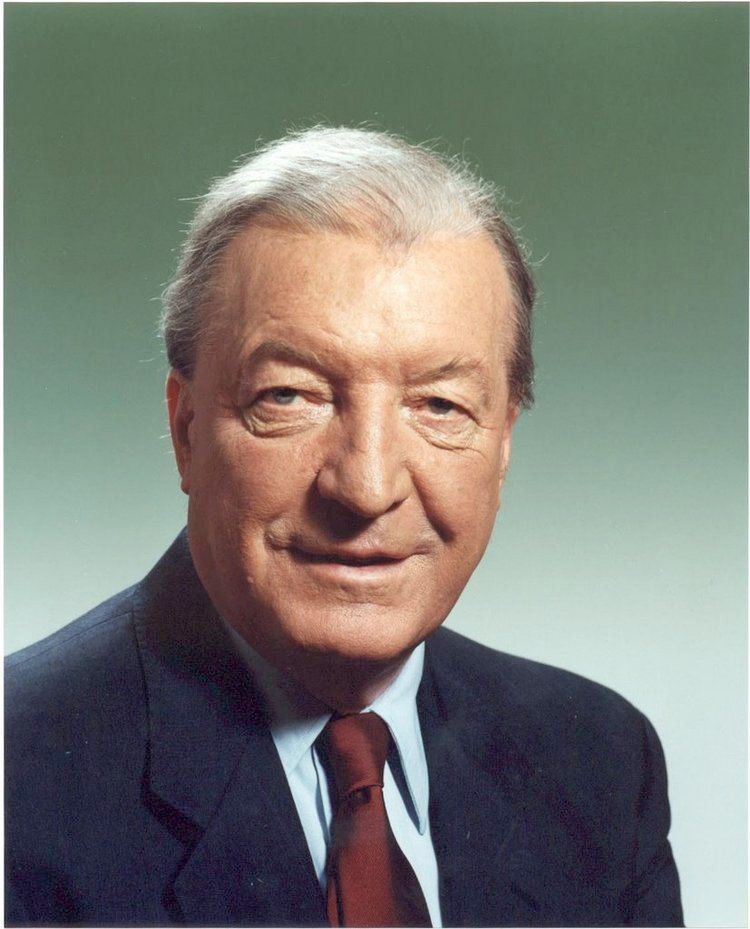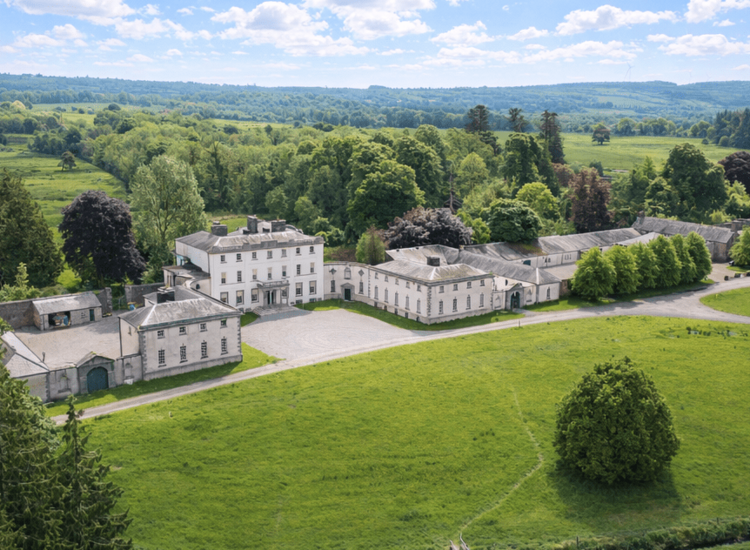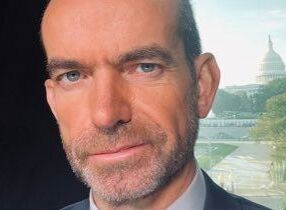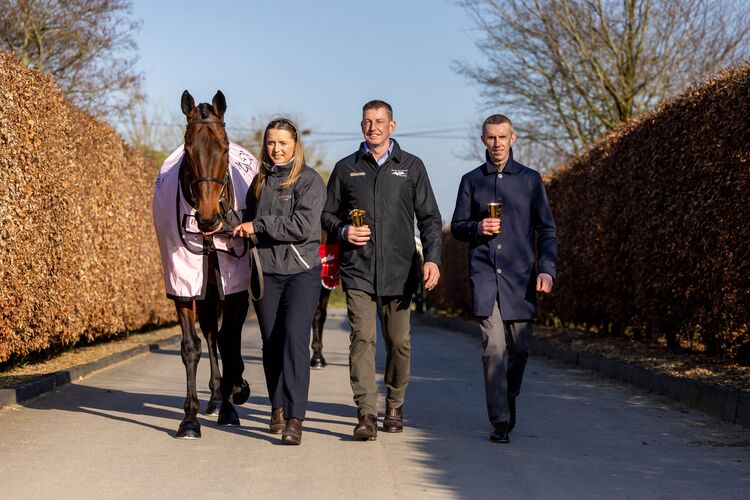THE MI6 SMEARMEISTER
Sir Maurice Oldfield, Chief of the British Secret Service, MI6, went to great lengths in the 1970s to influence U.S. political opinion in relation to Ireland.
While Foreign Office diplomats engaged in their usual sweet-talking and backslapping, the spymaster engaged in all sorts of subterranean dirty tricks.Charles Haughey, John Hume and Neil Blaney were on the receiving end of menacing smears generated by British propagandists. I describe the steps Oldfield took to denigrate these men in my book, "An Enemy of the Crown, The British Secret Service Campaign against Charles Haughey."
This is the first opportunity I have had to outline a parallel campaign which was directed against another important figure in U.S.-Irish affairs, Fr. Sean McManus of the Irish National Caucus.
Oldfield was Deputy Chief of MI6, 1968-73; Chief, 1973-78 and Coordinator of Intelligence in Northern Ireland, 1979-80. MI6 is attached to the Foreign Office and is the rough equivalent of America’s CIA.
In 1969 Oldfield and his colleagues penetrated an operation by the Citizen Defence Committees (CDCs) of Northern Ireland to import arms into Ireland.
Sir Maurice Oldfield.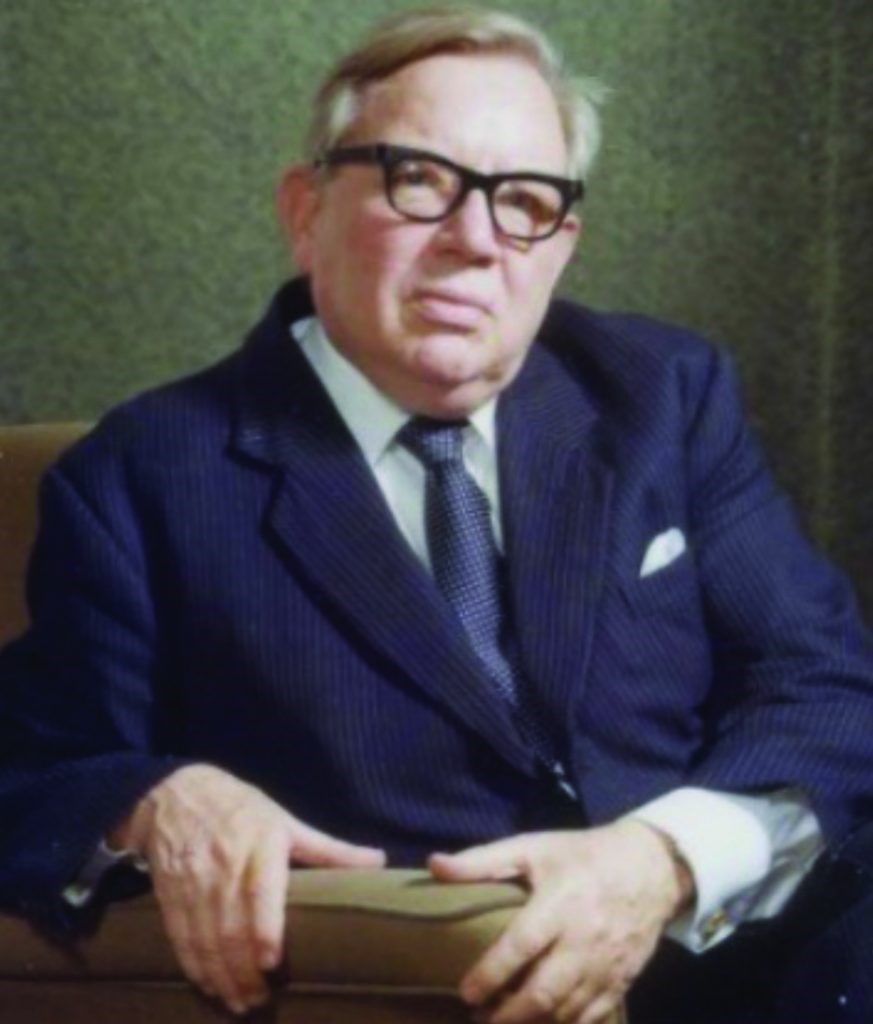
The CDCs had the assistance of Blaney, Haughey and Jim Gibbons in the endeavor. The trio were ministers in Jack Lynch’s cabinet.
THE WAFFEN SS MAN
The guns were to be held in a monastery in County Cavan and distributed in the event of a "doomsday situation" for Nationalists in Northern. MI6 knew what was going on because Otto Schleuter, the German arms dealer (and Waffen SS veteran) who was meant to have been selling arms to a captain in Irish military intelligence, was in fact keeping Oldfield abreast of developments.
The attempt to purchase the arms was relayed to the gardai by MI6 and helped spark the Arms Crisis of 1970. Haughey faced criminal charges in the Four Courts, but was acquitted.
After the dust of the Arms Crisis settled, Oldfield embarked on a decade-long mission to thwart the rehabilitation of Blaney and Haughey.
VIRGIL RANDOLPH III
The "political officer" at the U.S. embassy in Dublin in 1971 was Virgil Randolph III. If Randolph wasn’t a CIA officer, he was certainly fishing in the same waters as the spooks from Langley.
In May, 1971 Randolph was in contact with someone he later described as "an authoritative source in the Irish government." This individual somehow convinced him that three entirely separate wings of the IRA had come into existence: the Officials who were "under Communist influence," the Provisionals, and a one hundred-strong underground army he called "Blaney’s Private IRA." The notion that the latter organization existed is so farcical that it does not merit a rebuttal, but the "government" official was sufficiently convincing at the time to persuade Randolph of its existence.
On May 18, 1971, Randolph dispatched an eight-page confidential assessment of the IRA to Washington. It described Blaney’s “Private IRA” in some detail.I believe the "government" source was an MI6 mole in the Department of Justice in Dublin who was acting on orders from London to smear Blaney.
Blaney’s star shone brightly after the Arms Crisis and its sequel, the Arms Trials, but it fizzled out amid bouts of internal feuding which convulsed Fianna Fáil during 1971. Blaney was expelled from the party in 1972, never to return.
Neil Blaney.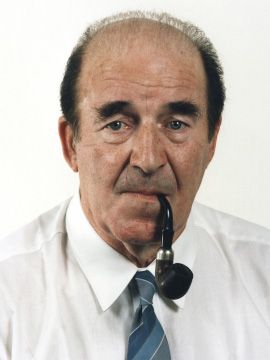
SPOOKS IN THE CASTLE
Colin Wallace of the British Army’ s Psychological Operations Unit (PsyOps) was kind enough to recount to me how he attended meetings at Stormont Castle from 1972 until 1975 with civilian black propagandists. Wallace felt the discussions that took place were unduly focused on plots against Haughey and other politicians rather than on terrorists. "We wanted to take on the paramilitaries. We couldn’t have cared less about Charlie Haughey. We couldn’t understand [the civilians] obsession with him," Wallace told me.
The Information Research Department (IRD) of the Foreign Office worked hand in glove with MI6 on smear campaigns. It was advised by the British Information Service (BIS) in the U.S. that American audiences were more interested in "dirt" than on links between their targets and the Soviet Union. The BIS wanted the IRD to do "a bit more digging" to uncover other discreditable or disruptive material which could be produced to undermine their targets.
Maurice Oldfield had a lot of spicy source material to deploy against Haughey. During the white heat of the Arms Crisis, Haughey had been hospitalized as a result of a horse-riding accident. Wallace recalls hearing stories about how Haughey had allegedly been hit over the head with a hurling stick "by the husband of a woman" with whom he was allegedly having an affair.
Wallace says this story was "deployed later as part of a plan to draw public attention to Haughey’s alleged 'lack of morality'"’A pamphlet entitled "Fianna Fail and the I.R.A," originally published by Official Sinn Féin, was reprinted with a new paragraph alleging Haughey was "an unashamed womaniser." This was mild stuff compared to the outrageous stories Oldfield planted in Private Eye magazine about Haughey and Terry Keane at the end of the decade which I describe in my book.
John Hume.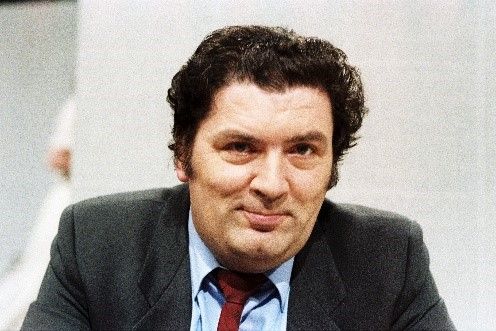
A FALSE LINK
In 1973, an Irish official approached the U.S. embassy in Dublin with "discreditable" information about Haughey, all of which was false. Significantly, the allegations were identical to those concocted at the Stormont Castle vilification conferences which Colin Wallace attended.
John Moore, the U.S. ambassador, transmitted a cable to Washington in April 1973 alleging that Haughey was directing the IRA to bomb certain parts of Belfast so he could purchase the damaged properties at a discount. Ludicrously, it was alleged that Haughey was in cahoots with the militant Loyalist Ulster Volunteer Force (UVF) to add to his imagined property portfolio.
Yet another U.S. Embassy cable was transmitted by Ambassador Moore on 11 November 1974, entitled "Haughey Tries for a Comeback."
It detailed how Haughey "has been making a speaking tour that is clearly a bid for a front bench seat. Previously a minister, Haughey fell from power and grace during the 1970 arms trial crisis. (He was involved in misappropriation of public funds for Northern Catholic extremists.) Since then, he has kept quiet and worked hard on back benches. Newspapers have always been fascinated by him, however, since he is one of [the] party’s few talented deputies. Current Fianna Fáil front bench is so weak that journalists love to speculate on ‘when Charlie will return.'
His reputation for shady real-estate deals does not seem to discourage his fans. Eventually, Haughey would certainly like to be party leader."
In reality, Haughey was surviving on a large overdraft from his bank.The cable’s recommendation to Washington was that "over [the] long-term, Haughey must be considered a serious challenger for [Taoiseach Jack] Lynch’s job, if only because the competition is so weak. We can entirely accept Lynch’s judgment that Haughey would be dangerous: nothing is less needed now than Republican opportunism."
HUME SMEARED
John Hume of the SDLP also became a target of Oldfield and his IRD attack dogs.
The Foreign and Commonwealth Office did not like the fact that Hume was making trips to Washington where he was forging relationships with the likes of Tip O’Neill, Ted Kennedy and other senior U.S. politicians.According to Hume’s biographer, Barry White, the British "watched from a distance, wary that he might try to pull the U.S. State Department away from its pro-London, anti-interventionist line.
Indeed, it was partly to break the State Department’s hold on policy that Hume concentrated on the politicians, who in America wield real power."
Some of Hume’s U.S. visits were as chairman of the Northern Ireland Resurgence Fund (NIRF), a charity which raised funds to encourage employment and self-help projects in Belfast. One of its early initiatives had been to raise money to rebuild Bombay Street, which rampaging Loyalist mobs had torched in 1969. In August 1972, Hugh Mooney of the Information Research Department, a former employee of the Irish Times, claimed some of the money raised by the NIRF had been diverted to the IRA, while Hume had carved off a slice for himself.
The IRD’s forgers manufactured a bank account purporting to show how Hume had stolen money from various U.S. charities. A briefing paper was concocted which linked the Derry man with IRA fundraisers and hinted that he had stolen money which had been donated by the Ancient Order of Hibernians in America.
According to the paper, Hume "received 10,000 dollars." Scribbled alongside this in red ink was "see bank a/c." The briefing paper was shown to certain American reporters. The smear oozed its way into The Christian Science Monitor, an international publication which, while it was available on subscription, was also distributed to influential political figures throughout the world free of charge. The story festered and spread until Hume was obliged to denounce it.
A section of an Information Research Department document used to smear Charles Haughey.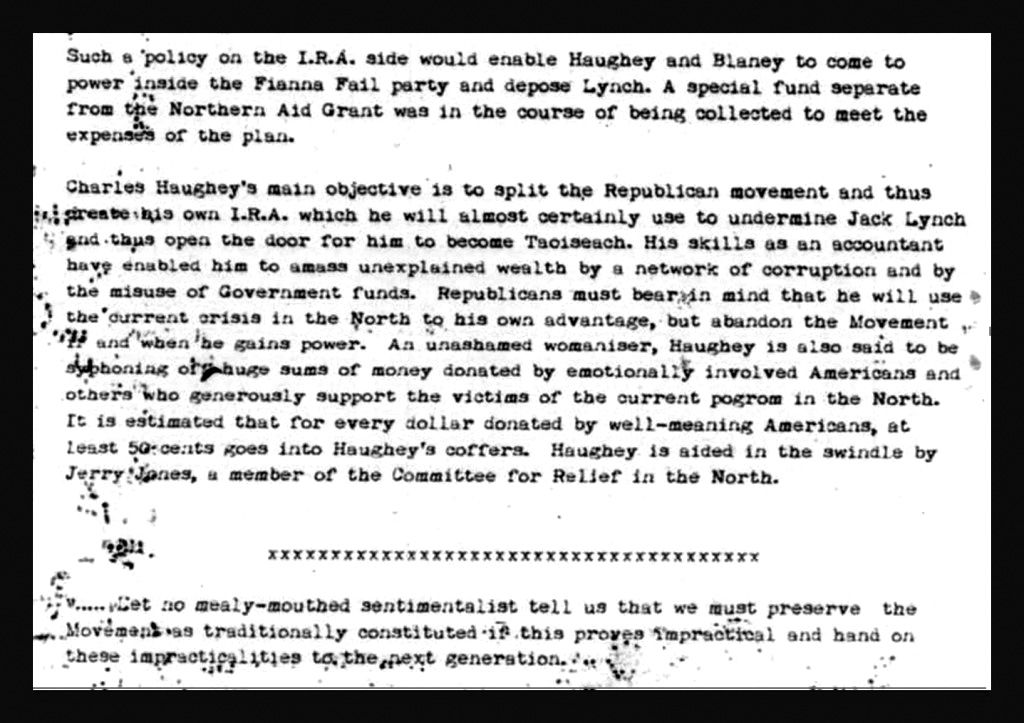
THE PRIEST FROM KINAWLEY
The same people at Stormont Castle who dreamt up the smears about Haughey also had Fr. Sean McManus, a priest from Kinawley, County Fermanagh, in their cross hairs.In the early 1970s, Fr. McManus was based at a Redemptorist monastery in Liverpool where Fr. Douglas Brice, one of his colleagues, started supplying information about him to Enoch Powell MP.
In 1972, Fr. Brice likened the Irishman and those who supported Irish independence to "fleas in the mattress." Powell relayed the information to a Detective Inspector Waller and, by 1973, Fr. Brice became a police informant.
Fr. McManus left Liverpool for the U.S. in 1972. In 1974 he founded the Irish National Caucus (INC). Like Hume, he became a threat to the FCO’s stranglehold over the State Department. What I would describe as a smear "bible" had been drawn up by the spooks at Stormont Castle into which they inscribed all the dirt they hoped to disseminate about Haughey, Fr. McManus, and others. The "bible" attempted to portray the latter as an IRA gunrunner.
These and other smears were deployed against Fr. McManus for decades, especially when he was promoting the MacBride Principles on fair employment. Britain smeared the INC as a front for the Provisional IRA.
FLOPS
All of these campaigns were hopeless failures. Blaney left Fianna Fáil due to internal disputes, not because of Oldfield’s smears. Haughey, of course, went on to become taoiseach on four occasions.
John Hume gained access to all the important U.S. politicians and rose to become leader of the SDLP. He was central to the Good Friday Agreement and went on to win the Nobel Peace Prize.
Fr. Sean McManus with future president Bill Clinton.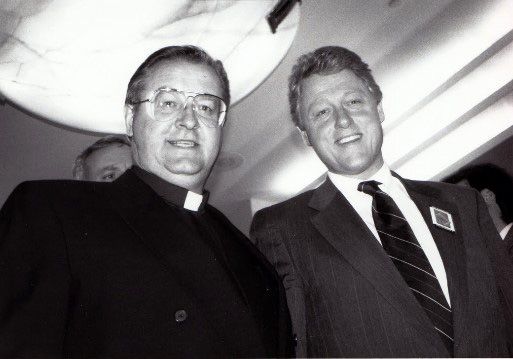
Fr. McManus drove the campaign to implement the MacBride Principles, ultimately with enormous success.
A CAREER IN TATTERS
Ironically, it was Oldfield, the supreme smearmeister, whose career ended in tears.
Oldfield fell out with his rivals of MI5 (attached to the Home Office - the rough equivalent of the FBI). They discovered that he was sexually attracted to young males and dragged him in for questioning.
Eventually, he confessed to this weakness. An MI5 report submitted to the Cabinet Secretary, Sir Robert Armstrong, on 31 March 1980, revealed that after "some preliminaries" Oldfield had acknowledged that he "had first been introduced to homosexuality at university and he admitted having engaged in homosexual practices, intermittently, up till the time of his acceptance of his Northern Ireland appointment. His relationships were, for the most part, with restaurant waiters and the like: he had none, he said, with (MI6) staff or agents."
When Prime Minister Margaret Thatcher learned of this, Oldfield’s security clearance was withdrawn while an enquiry was carried out to see if he had been compromised by a foreign intelligence service such as the KGB.
It was determined that he had not, but his career now lay in tatters. He soon discovered he had cancer. The following May, he asked Thatcher to relieve him of his Northern Ireland duties on the grounds of ill-health. He died on March, 11 1981.
When Haughey read the newspaper reports about Oldfield’s departure from Northern Ireland in 1980, and his death the following year, he may very well have suspected that the English spymaster had been involved in the intrigues directed against him. But, if so, he never made any public pronouncement about Oldfield.
Haughey served as leader of Fianna Fail until February 1992, nearly twelve years after Oldfield’s departure from Ireland."
An Enemy of the Crown, The British Secret Service Campaign against Charles Haughey," by Dublin-based David Burke is published by Mercier Press, Cork (www.mercierpress.ie) and is available on Amazon.

